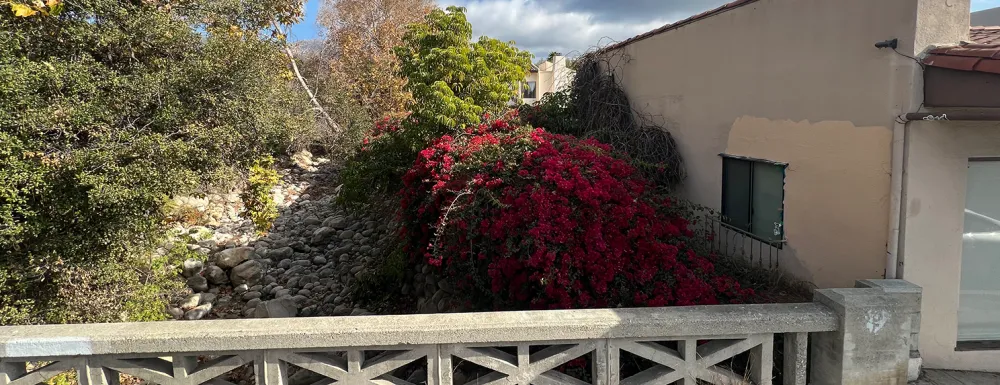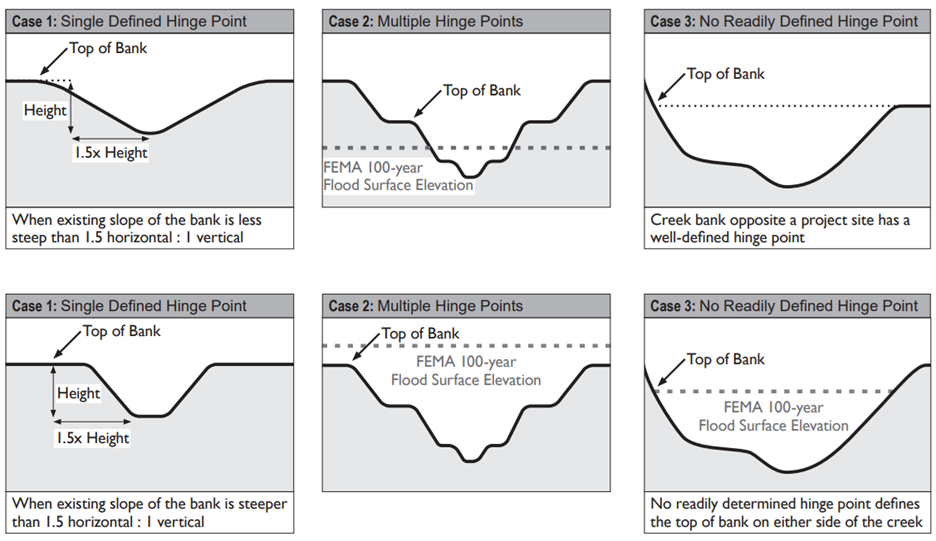Storm update: SBA has reopened and all flights are cleared to resume normal operations
All SBPL locations will be closed from 12/22 through 12/26 and on 1/1/26 for the winter holidays. For all the details about adjusted hours and closures, visit our Winter Holiday Hours page.

Contact
Melissa Hetrick
Resilience Program Supervisor
(805) 991-2447
MHetrick@SantaBarbaraCA.gov
Submit Comments To:
CreekBuffers@SantaBarbaraCA.gov
Map of City Creeks
Sign Up for News
Creek Buffer Ordinance FAQ
Creek buffers or setbacks are natural areas between creeks and development.

Creek buffers are needed to:
- Reduce public safety risks related to erosion and flooding. Fast flowing creeks erode creek banks and can undercut or flood structures.
- Prevent redirection of creek flows and storm water runoff to unsuitable areas. When development is placed in a creek or drainage it can speed up or deflect flows leading to new erosion downstream. Development placed too close to a creek will increase storm water runoff and can lead to increased bank erosion as that water makes its way to the creek.
- Improve creek and ocean water quality as rain can soak into the ground and pass through vegetation before flowing into creeks.
- Preserve creek habitats where fish, birds, and other wildlife live. Trees and other creek habitats can help maintain creek bank stability, provide wildlife habitat, and improve water quality through shading.
The draft ordinance applies to creeks that meet the following definition:
“Creek” means a naturally occurring watercourse that conveys water seasonally or year around and having a bed and banks that may be in a natural state or artificially stabilized.
This definition is consistent with the definition of a creek in the State Fish and Wildlife Code and the City’s Coastal Land Use Plan. A screening map showing the general location of various types of creeks can be found at www.SantaBarbaraCA.gov/CreekBuffers. This map is to be used only for screening purposes. The map is not part of the ordinance but is simply a guide to indicate where a creek may be. The final call on whether a drainage meets the definition of “minor creek” would be based upon on the ground conditions. Major creeks are identified in the ordinance and were determined based on the size of the watershed or drainage area above the creek.
| The ordinance proposes the following buffer distance between creeks and new development | |
|---|---|
| Major Creeks | 50 feet from top of bank |
| Public Flood Control Project Reach | 35 feet from top of bank |
| Minor Creeks | 15 feet from top of bank |
Major Creeks: Arroyo Burro; Arroyo Honda; Chelham Creek; Cieneguitas Creek; Coyote Creek; Laguna Creek; Las Positas Creek; Lighthouse Creek; Mesa Creek; Mission Creek; Old Mission Creek; Rattlesnake Creek; San Roque Creek; Sycamore Creek (East, Middle, and West forks); Toyon; and Westmont Creek.
Public Flood Control Project Reach: Arroyo Burro (reach between Hope Ave. and Hwy. 101); Las Positas Creek (reach between Las Positas Place and Veronica Springs Road); and Mission Creek – Caltrans Channels (approximately Los Olivos Street to Mission Street and Arrellaga Street to Canon Perdido) and the concrete-lined and walled portions of the Lower Mission Creek Flood Control Project.
Minor Creeks: These are those drainages that meet the definition of a creek on the ground (have a defined bed and a bank) but are not listed above as a major creek.
Most creeks and drainages in the Santa Barbara area only flow during the rainy season. But when they flow, they can cause a lot of erosion and flooding quickly. The City’s goal with small “minor creeks” is to prevent development in or directly adjacent to a drainage that could be susceptible to erosion or redirect flows during rains to neighboring properties or unsuitable areas.
Existing legal development and structures in the buffers can remain in place and be repaired and maintained. Minor remodels such as kitchen remodels, window replacements, or replacement of roof shingles can occur. Additions can also occur if the portion of the structure added is outside the buffer. The City is not proposing to remove any existing legal structures or development as part of this draft ordinance. The draft ordinance sets limitations only on new structures or substantially redeveloped structures (more than 50% of structural components are rebuilt).
Creek buffers or setbacks are already required for many permit applications and to comply with State required environmental review. However, for most of the city, the buffer distances are determined on a case-by-case basis, based on applicant-prepared technical reports. This process has led to inconsistent outcomes over time and prolonged development application reviews. The draft ordinance would take the guesswork out of the permitting process, providing clear objective standards for creek buffers that apply citywide consistently and efficiently.
- Santa Barbara County requires creek buffers ranging from 50’ in urban areas to 100’ in rural areas.
- City of Goleta requires 100’ creek buffers.
- City of Carpinteria requires 50’ creek buffers.
The City of Santa Barbara is the only jurisdiction in the region to not have a comprehensive creek buffer ordinance.
Federal and state agencies including the Army Corp of Engineers, the State Water Resource Control Board, the Department of Fish and Wildlife, among others.
In these cases, the replacement structures or development would need to be located outside the creek buffer area when possible. If there is no space on the lot for reconstruction outside of the buffer of the same size house as previously existed, then the structures may be rebuilt on the lot to the previously existing square footage within the buffer if they are located as far away from the creek as possible and safety findings can be made for the life of the structure. The purpose of these provisions is to increase the safety of structures over time.
Flood insurance rates are based on a property’s compliance with federally mapped flood insurance zones (FEMA Flood Maps) and associated floodproofing standards for structures. The creek buffer ordinance would not alter these federally established flood insurance rates or standards. Vegetation management or fuel management on properties for fire protection purposes is allowed without any approvals in the draft creek buffer ordinance. Additionally, home hardening activities also required by some fire insurance companies such as replacing windows, protecting eaves, and clearing five feet around structures in high fire hazard areas are all allowed to occur in the creek buffer areas without additional permits.
The draft creek buffer ordinance contains objective criteria with illustrations for determining the top of the creek bank. The top-of-bank definition is consistent with that used by Santa Barbara County with additional detail. As part of revisions to the draft ordinance, City staff are investigating ways to make the determination of the top of the bank on minor creeks and associated buffers simpler.

Some developments and actions are allowed within creek buffers without any type of prior approval. These include actions such as maintaining property and structures and conducting vegetation management for fire protection in high-fire hazard zones. Some structures or developments are also allowed within buffers as part of what is called a zoning clearance (staff zoning plan check). When building permits are obtained, the permit applications are routed to zoning staff who check that the municipal code is being met and that no additional permits are needed for the work. Minor developments such as new fences, new stormwater management devices, and new ADA pathways are allowed to be in creek buffers if they meet the standards in the ordinance. For severely constrained lots, there is a discretionary modification process to allow for the replacement of major structures within buffers when safety findings can be made.
Accessory dwelling units (ADU’s) that are currently allowed by the municipal code and state law would still be allowed under the draft buffer ordinance outside of creek buffers. Certain types of ADU’s mandated by state law can still be placed within creek buffers if there is not sufficient space on the lot outside the buffer to fit the ADU and they are found to be safe from erosion. See Section 22.26.120 of the draft ordinance for information on ADUs.
The creek buffer ordinance conforms with all current state laws addressing accessory dwelling units (ADUs), multifamily housing, and other forms of housing. Section 22.26.120 of the ordinance allows state mandated accessory dwelling units within buffers if there is not sufficient space outside the buffer for the ADUs and the ADUs are safe from erosion. Section 22.26.090.F of the ordinance allows for multifamily and other housing to be built partially within the creek buffer to densities currently allowed in the zoning code if there is not sufficient space outside the buffer to accommodate the structures and if the structures are deemed safe from erosion hazards.
Comments or questions can be sent to CreekBuffers@SantaBarbaraca.gov. The ordinance and screening map of creeks is available at www.SantaBarbaraCA.gov/CreekBuffers. Feel free to also contact Melissa Hetrick, Resilience Program Supervisor, at 805-991-2447 or mhetrick@santabarbaraca.gov with any questions or concerns.
